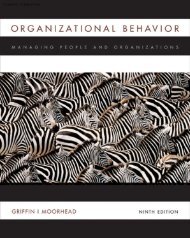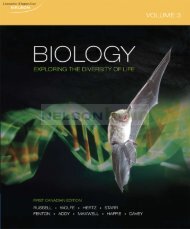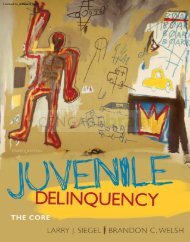Understanding Statistics in the Behavioral Sciences ... - NelsonBrain
Understanding Statistics in the Behavioral Sciences ... - NelsonBrain
Understanding Statistics in the Behavioral Sciences ... - NelsonBrain
Create successful ePaper yourself
Turn your PDF publications into a flip-book with our unique Google optimized e-Paper software.
Licensed to:<br />
14 C H A P T E R 1 <strong>Statistics</strong> and Scientifi c Method<br />
WHAT IS THE TRUTH? Data, Data, What Are <strong>the</strong> Data?—1<br />
In <strong>the</strong> previous<br />
“What Is <strong>the</strong> Truth?”<br />
sections, no data<br />
were presented to<br />
justify <strong>the</strong> authors’<br />
claims, a card<strong>in</strong>al error <strong>in</strong> science. A<br />
little less grievous, but none<strong>the</strong>less<br />
questionable, is when data are presented<br />
<strong>in</strong> a study or experiment but<br />
<strong>the</strong> conclusions drawn by <strong>the</strong> authors<br />
seem to stay far from <strong>the</strong> actual data.<br />
A study reported <strong>in</strong> a recent newspaper<br />
article illustrates this po<strong>in</strong>t. The<br />
article is shown below.<br />
CAVEMEN WERE PRETTY<br />
NICE GUYS<br />
By VIRGINIA FENTON<br />
The Associated Press<br />
PARIS—Neanderthals might not<br />
have been as savage as we th<strong>in</strong>k.<br />
A 200,000-year-old jawbone<br />
discovered <strong>in</strong> France suggests <strong>the</strong><br />
primitive hom<strong>in</strong>ids took care of each<br />
o<strong>the</strong>r, <strong>in</strong> this case feed<strong>in</strong>g a toothless<br />
peer, an <strong>in</strong>ternational team of<br />
experts said Friday.<br />
A damaged jawbone, discovered<br />
last year <strong>in</strong> sou<strong>the</strong>rn France,<br />
shows that its owner survived without<br />
teeth for up to several years—<br />
impossible without a help<strong>in</strong>g hand<br />
from his or her peers, said Canadian<br />
paleontologist Serge Lebel.<br />
Lebel directed an <strong>in</strong>ternational<br />
team of experts who discovered<br />
<strong>the</strong> fossil <strong>in</strong> July 2000. Also on <strong>the</strong><br />
team was <strong>the</strong> noted specialist of <strong>the</strong><br />
Neanderthal period Erik Tr<strong>in</strong>kaus of<br />
Wash<strong>in</strong>gton University <strong>in</strong> St. Louis<br />
and colleagues from Germany,<br />
Portugal and France.<br />
“This <strong>in</strong>dividual must have<br />
been quite weak and needed<br />
preparation of his or her food, and<br />
<strong>the</strong> social group probably took care<br />
of him or her,” Lebel said at a news<br />
conference.<br />
“We mustn’t dehumanize <strong>the</strong>se<br />
be<strong>in</strong>gs. They show an entirely human<br />
k<strong>in</strong>d of behavior,” said Lebel,<br />
who works at <strong>the</strong> University of<br />
Quebec.<br />
“O<strong>the</strong>rs <strong>in</strong> <strong>the</strong> group may have<br />
gone as far as chew<strong>in</strong>g <strong>the</strong> food for<br />
<strong>the</strong>ir sick peer, as well as cutt<strong>in</strong>g<br />
and cook<strong>in</strong>g it,” he said.<br />
“The discovery may push back<br />
ideas of <strong>the</strong> beg<strong>in</strong>n<strong>in</strong>g of social<br />
care by 150,000 years,” Lebel said.<br />
“A similar <strong>in</strong>fection that caused a<br />
hom<strong>in</strong>id to lose his teeth had previously<br />
only been found <strong>in</strong> fossils dat<strong>in</strong>g<br />
back 50,000 years,” he said.<br />
The team’s fi nd<strong>in</strong>gs were published<br />
<strong>in</strong> <strong>the</strong> Sept. 25 issue of <strong>the</strong><br />
U.S. periodical Proceed<strong>in</strong>gs of <strong>the</strong><br />
National Academy of <strong>Sciences</strong>.<br />
However, University of<br />
Pittsburgh anthropologist Jeffrey<br />
Schwartz was skeptical.<br />
“You can eat a lot without your<br />
teeth. There is no reason to th<strong>in</strong>k<br />
<strong>the</strong> <strong>in</strong>dividual couldn’t have been<br />
chew<strong>in</strong>g soft food—snails, mollusks,<br />
even worms.”<br />
Repr<strong>in</strong>ted with permission of The<br />
Associated Press.<br />
Do you th<strong>in</strong>k <strong>the</strong> fi nd<strong>in</strong>g of a<br />
200,000-year-old, damaged jawbone<br />
by <strong>the</strong> <strong>in</strong>ternational team of experts<br />
is an adequate database for <strong>the</strong> conclusions<br />
put forth by Dr. Lebel? Or,<br />
like Dr. Schwartz, are you skeptical?<br />
You can probably guess <strong>in</strong>to which<br />
camp I fall. ■<br />
Copyright 2011 Cengage Learn<strong>in</strong>g. All Rights Reserved. May not be copied, scanned, or duplicated, <strong>in</strong> whole or <strong>in</strong> part. Due to electronic rights, some third party content may be suppressed from <strong>the</strong> eBook and/or eChapter(s).<br />
Editorial review has deemed that any suppressed content does not materially affect <strong>the</strong> overall learn<strong>in</strong>g experience. Cengage Learn<strong>in</strong>g reserves <strong>the</strong> right to remove additional content at any time if subsequent rights restrictions require it.















